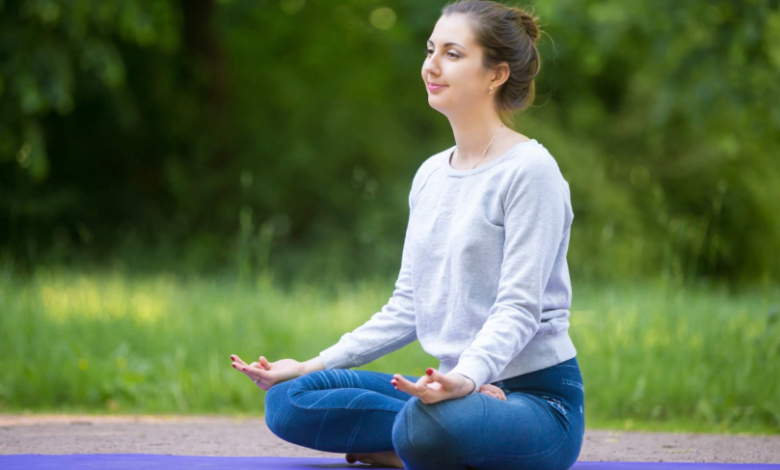How Is Meditation Important to Buddhism’s Inner Peace?

Inner peace begins when the mind becomes still and the heart grows quiet. Meditation offers this stillness, allowing individuals to step away from stress, confusion, and emotional noise. To understand how is meditation important to buddhism, we need to see how it helps calm the mind and bring balance, leading to peace and clarity. In Buddhism, meditation helps you become more aware, let go of clinging to things, and feel deep inner calm. It guides you to look within yourself to find true peace and understanding.
How Meditation Helps Calm the Mind
Meditation is a powerful way to help your mind feel calmer and clearer. Here’s how it works and why it helps:
1. Activates the Relaxation Response
When you meditate, your body enters a calm state called “rest and digest.” This lowers stress chemicals, slows your heartbeat, and lowers blood pressure, helping you feel peaceful and relaxed naturally.
2. Focuses Your Mind on the Present
Meditation helps you stay present and focused, even when your mind wanders. Just 10 minutes a day can improve concentration and reduce distractions.
3. Helps You Manage Emotions
Meditation helps you become aware of your thoughts and feelings, so you can take a moment before reacting. This makes it easier to feel less anxious, sad, or stuck in overthinking.
4. Changes Your Brain Activity
Meditation enhances brain function by boosting focus, emotional regulation, and self-awareness. Practices like loving-kindness meditation can even shift brain activity to support better emotional balance.
5. Builds a Stronger, Healthier Brain Over Time
Regular meditation often leads to stronger connections and thicker brain regions associated with attention, memory, and emotional balance.
Meditation helps “rewire” your brain for more calm, focus, and resilience.
See also: 3331902178 Communication Solutions: Reliable and Secure Connectivity for Businesses
Easy Techniques to Help You Feel Calm
- Breath Awareness (Anapanasati): This meditation focuses on paying attention to your breathing.
- Sit comfortably and notice your breath as it goes in and out.
- Feel the air moving through your nose, or how your chest or belly rises and falls.
- If your mind wanders, gently return your attention to your breath.
Doing this helps calm your busy thoughts and makes it easier to concentrate.
Box Breathing: Box breathing is a way to help you feel calm and focused.
- Breathe in slowly for 4 counts.
- Hold your breath for 4 counts.
- Breathe out slowly for 4 counts.
- Hold again for 4 counts.
Repeat this pattern a few times. The steady rhythm helps relax your body and clear your mind.
- Body Scan Meditation: Body scan meditation helps you relax and feel more connected to your body.
- Close your eyes and breathe slowly.
- Focus on one part of your body at a time, starting at your feet and moving up to your head.
- Notice any tightness, pain, or sensations.
- Try to relax each area as you focus on it.
This practice helps you release tension and experience a deeper sense of calm.
- Loving-Kindness (Metta) Meditation: Loving-kindness meditation helps you feel more caring and peaceful.
- Sit quietly and close your eyes.
- Silently say kind phrases to yourself, like: “May I be safe. May I be calm.”
Next, send kind wishes to others, even to those you find difficult
This practice helps you feel more positive, kind, and emotionally balanced.
How to Get Started
- Start small: Start with just 2 to 10 minutes of meditation each day. Even a short time like this can help you feel calmer and more focused.
- Mix it up: Try meditation while sitting, walking, eating, or doing daily chores.
- Find what suits you: Test different styles and keep what feels good for you.
- Notice progress: Pay attention to any changes, like staying calmer in stressful situations, sleeping more peacefully, or finding it easier to concentrate.
Meditation isn’t about getting rid of your thoughts or feelings. It’s about learning to focus your attention and respond calmly to what’s going on inside and around you. With regular practice, it helps you develop a clearer, more peaceful mind, leading to greater understanding, inner strength, and well-being.
Letting Go Through Meditation
Letting go through meditation means gently loosening your hold on thoughts, emotions, or desires that upset your peace. Instead of fighting or avoiding what you feel, you watch experiences come and go without getting caught up in them. In Buddhism, this helps reduce suffering because you’re not stuck clinging to who you think you are, what you expect, or what you own.
How Meditation Helps You Let Go
- Mindful Observation: Notice thoughts and feelings as they come up. Label them gently, then let them pass without judging them.
- Seeing Impermanence: Everything comes and goes, so understanding this helps you let go more easily.
- Creating Space: Observing tension or cravings without reacting allows them to soften and fade naturally.
- Compassionate Acceptance: Instead of fighting or avoiding difficult emotions, meet them with kindness and gentle awareness.
Practical Techniques
- Mindful Watching: Notice thoughts or feelings, drop the story behind them, and return your focus to the present moment.
- Body Anchor: Scan your body for areas of tension connected to emotions and breathe into those spots to help release the tightness.
- Letting-Go Breath: As you exhale, silently say the words “Let go,” and imagine stress or worries leaving your body.
- Visualization: Imagine your worries drifting away like a balloon or a leaf on a stream.
- Investigating Attachments: Investigating attachments means noticing what you’re holding onto and remembering it’s not permanent or part of your true self.
Benefits of Letting Go
- Immediate: You feel calmer, breathe more easily, and react less strongly to stress.
- Deep Insight: You realize that even strong attachments are temporary and not permanent parts of who you are.
Meditation helps you let go, see that everything changes, and approach life with kindness, bringing inner peace and freedom.
Experiencing True Serenity
“Experiencing True Serenity” is about creating a calm, clear, and steady mind that shapes your daily life.
- Mindfulness & Presence: Focus on what you’re doing in this moment. Breathe slowly and look closely at small details, like how food tastes or how your feet feel when you walk. This helps you feel calm and keeps your mind clear.
- Acceptance & Non-Attachment: Accept what you can’t control, observe thoughts without judging them, and let them pass.
- Gratitude & Positivity: Keep a gratitude journal to shift your focus from stress to appreciation, building emotional resilience.
- Nature & Simplicity: Spend time in nature and keep your space tidy. This helps lower stress and brings more calm and peace.
- Physical Activity & Self-Care: Exercise, eat well, and rest to support relaxation and emotional balance.
- Deep Insight: Real peace comes from being calmly aware, not from intense or dramatic meditation experiences.
The essence of serenity is living with steady awareness, acceptance, and balance. By practicing these habits daily, serenity becomes a lasting part of your life rather than just a temporary feeling.



